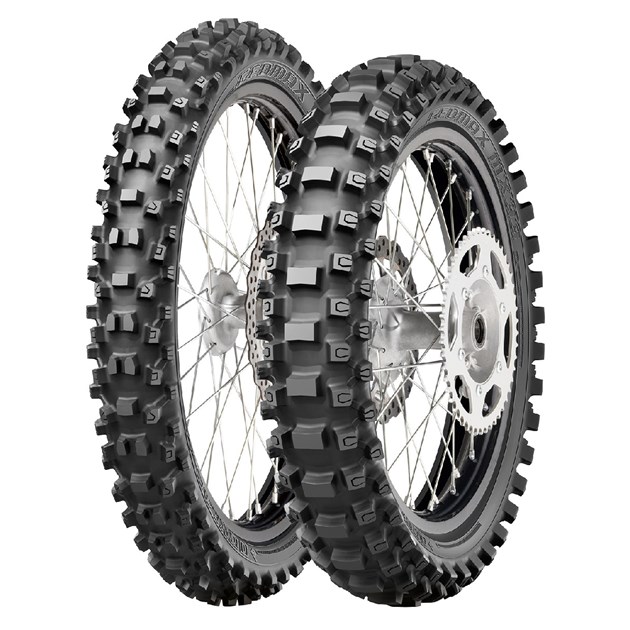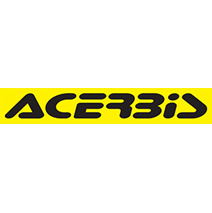Dunlop 70/100-10 mx33
Manufacturer: DUNLOP
SKU: DUNLOP*70/100*10MX33
Geomax MX33 successor to the MX3S soft terrain tyre. Geomax MX33 tyres for driving on variable surfaces. Improved tread with connectors between the sh Show all
Not in stock
Geomax MX33 successor to the MX3S soft terrain tyre. Geomax MX33 tyres for driving on variable surfaces. Improved tread with connectors between the shoulder blocks, which together with the new block layout increases resistance to cracking when riding on hard surfaces. Dunlop has also incorporated its Carcass Tension Control System into the new tyre, further improving ride feel and handling.
Product parameters
Brand: Dunlop
Terrain: Sand, Mud, Medium Terrain, Hard Surface
Design: MX33
Width: 70
Profile: 100
Dimensions in inches: 10
Load index: 41 (145 kg)
Speed index: J (100 km/h)
TT/TL: Normal (TT)
Position: Rear
Use and maintenance
Store tyres clean and away from sources of heat, light, ozone or hydrocarbons. Avoid prolonged exposure of tyres to direct sunlight.Avoid any contact with grease, petrol, volatile solvents or other agents that may damage the rubber. Avoid horizontal storage of tubeless tyres, only small tyres can be stored horizontally (maximum 6 months). If tyres are stored horizontally, they must be placed tooth to tooth. If tyres are stored mounted on the rim, reduce the inflation pressure.Make sure there is no water or moisture inside the tyre. Never store tyres in direct contact with the ground for long periods of time. For safety reasons, tyres should only be repaired by experts using the correct methods and tools. When loading a tyre, the relationship between speed, inflation pressure and load capacity must be taken into account. Overloading causes premature destruction of the tyre. Use technical documentation and inflation tables that define the load and inflation for different operating speeds. Under-inflation is not only caused by improper run-flatting, but also by liner separation or other damage to the tyre liners. Overinflation increases the hardness of the tyre and reduces the resistance to impacts leading to damage to the tyre liners.
Mounting and dismounting instructions
Fitting and removing tyres can be dangerous and should only be carried out by trained and qualified personnel using the correct tools and working procedures. Failure to follow these procedures may result in incorrect fitting of the tyre to the rim and subsequently cause the tyre to be destroyed with explosive force, which can cause serious injury or death. Make sure the rim, tire and tube are compatible. Check that the tyre is suitable for the equipment/machine. Use only rims recommended or approved by the tire manufacturer. Always use only the correct special equipment and tools. The rim must be clean and in perfect condition (not damaged etc.), if necessary clean the rim with sandpaper. Under no circumstances fit tyres to rims that are cracked, seriously deformed, have welding repair marks, etc.Carefully inspect the inside as well as the outside of the tyre to identify any damage. If the extent of the damage does not allow repair, the tyre should be devalued. If mounting with a tube, always use the correct new tube and liner for the size. For mounting tubeless tires, on tubeless rims, always use a new tubeless valve.Lubricate the rim and bead before mounting. Use only a suitable lubricant that will not destroy the tire (never use silicone or gasoline based lubricants).Vertical mounting is recommended. In the case of horizontal mounting, it is essential to check that the bottom bead fits correctly.Fit the tyre onto the rim opposite the valve hole (respect the direction of rotation indicated by the arrows). Using the mounting lever, gradually slide the first bead over the rim rim rim rim. Then insert a lightly inflated inner tube, sufficiently treated with a slip joint (if fitted), into the rim. Position the valve and secure it lightly with the retaining ring. Insert the second foot, working in sequence so that you end up at the valve.To seat and centre the shell correctly, remove the inner valve liner. Slowly inflate and check for proper seating of the casing foot. Make sure the casing foot has not pinched the soul. Maintain a safe distance during the densification process, always use a safety cage, preferably attached to a wall or safety chain. During pressure readings, make sure that no part of your body is in the possible trajectory of the valve internals or its cap. It is recommended to use a suitable device to limit the inflation pressure. Use a filter and dehumidifier for the compressed air necessary to remove moisture and dust.If the feet are not seated properly, release the air, re-pressurize and inflate. Repeat this operation until the feet are seated correctly. If all the previous operations have been carried out correctly, fit the inner valve insert. Inflate the tyre according to the load Make sure that the valve does not touch the rim, brake drums or other mechanical parts.RemovalNever attempt to remove the beads of an inflated tyre. Always remove the inner valve insert. Check that the tyre is completely free of air before dismounting. Never use tools that may damage the rim or tire beads.
Call us, we are glad to help...

Jiri Fulin
Bike lover & your support
+420 736 164 904
obchod@mefo.cz
 MOTORCYCLES PLASTICS
MOTORCYCLES PLASTICS AIR BOX & AIR BOX COVER
AIR BOX & AIR BOX COVER EXHAUST PROTECTION
EXHAUST PROTECTION HANDGUARDS
HANDGUARDS  LOVER FORK COVERS
LOVER FORK COVERS SWINGARM PROTECTION
SWINGARM PROTECTION TANK COVER
TANK COVER MUD FLAP
MUD FLAP SKID PLATE
SKID PLATE DISC COVER
DISC COVER FRAME PROTECTOR
FRAME PROTECTOR INGNITION & CLUTCH COVER
INGNITION & CLUTCH COVER HEADLIGHT MASK
HEADLIGHT MASK RADIATOR LOUVERS
RADIATOR LOUVERS  TANK
TANK SIDE PANELS
SIDE PANELS FRONT FENDER
FRONT FENDER FRONT NUMBER PLATE
FRONT NUMBER PLATE SEAT
SEAT RADIATOR SCOOPS
RADIATOR SCOOPS PLASTIC SCREWS
PLASTIC SCREWS CHAIN GUIDE
CHAIN GUIDE REAR FENDER
REAR FENDER FILTERS
FILTERS AIRBOX COVER
AIRBOX COVER OIL FILTER
OIL FILTER DUST FILTER
DUST FILTER ENGINE PARTS
ENGINE PARTS SEALS
SEALS CYLINDER HEAD
CYLINDER HEAD CARBURETOR
CARBURETOR CRANKSHAFT
CRANKSHAFT FRICTION PLATES
FRICTION PLATES PISTON KIT
PISTON KIT TIMING CHAIN
TIMING CHAIN CLUTCH & ACCESSORIES
CLUTCH & ACCESSORIES SPARK PLUG AND ELECTRO
SPARK PLUG AND ELECTRO engine covers
engine covers CHASSIS PARTS
CHASSIS PARTS CALIPER REBUILD KIT
CALIPER REBUILD KIT BRAKE PADS
BRAKE PADS BRAKE DISC & BOLTS
BRAKE DISC & BOLTS BRAKE PEDAL
BRAKE PEDAL HOSE
HOSE COOLER
COOLER WHEELS, RIMS & SPOKE
WHEELS, RIMS & SPOKE SWINGARM
SWINGARM CABLE
CABLE LEVERS & PERCH
LEVERS & PERCH THROTTLE TUBE
THROTTLE TUBE SEALS
SEALS SHIFT LEVER
SHIFT LEVER SPROCKET & SCREW
SPROCKET & SCREW FRONT SPROCKET
FRONT SPROCKET STEERING
STEERING LINKAGE KIT
LINKAGE KIT LAUNCH CONTROLS
LAUNCH CONTROLS FOOTPEGS
FOOTPEGS SHOCK ABSORBERS
SHOCK ABSORBERS EXHAUST
EXHAUST



 helmets
helmets adventure
adventure junior
junior retro
retro accessories
accessories goggles
goggles GLASS, TEARS OFF...
GLASS, TEARS OFF... PROTECTION
PROTECTION BODY PROTECTOR
BODY PROTECTOR NECK PROTECTOR
NECK PROTECTOR KIDNEY BELT
KIDNEY BELT ELBOW GUARDS
ELBOW GUARDS KNEE GRUARDS
KNEE GRUARDS JUNIOR PROTECTOR
JUNIOR PROTECTOR BOOTS OFF ROAD/DUAL ROAD
BOOTS OFF ROAD/DUAL ROAD travel
travel ankle boots
ankle boots touring enduro
touring enduro junior
junior soles and more
soles and more jersey
jersey JUNIOR
JUNIOR JACKET
JACKET TEXTILE/ENDURO
TEXTILE/ENDURO back rpotector
back rpotector PANTS
PANTS junior
junior TEXTILIE
TEXTILIE  GLOVES
GLOVES dual road
dual road T-SHIRTS
T-SHIRTS SOCKS
SOCKS WATERPOOF GEAR
WATERPOOF GEAR CAP, NECK
CAP, NECK SWEATSHIRT
SWEATSHIRT VEST
VEST GRAPHICKITS, NUMBERS
GRAPHICKITS, NUMBERS HANDGUARDS
HANDGUARDS MOTOCROSS/ENDURO
MOTOCROSS/ENDURO ATV (QUAD)
ATV (QUAD) DUAL ROAD
DUAL ROAD HANDGUARDS MOUNTS
HANDGUARDS MOUNTS COMPLET THROTTLE
COMPLET THROTTLE TRANSPORT
TRANSPORT TOOLS
TOOLS SPANNER & SPRING TOOL
SPANNER & SPRING TOOL TIRE IRON
TIRE IRON  CHAIN BREAKER
CHAIN BREAKER OTHER MOTO TOOLS
OTHER MOTO TOOLS OIL, CLEANER
OIL, CLEANER FORK OIL
FORK OIL MOTOR OIL
MOTOR OIL GEAR OIL
GEAR OIL AIR FILTER OIL
AIR FILTER OIL CHAIN LUBE
CHAIN LUBE COOLANT FLUID
COOLANT FLUID BRAKE FLUID
BRAKE FLUID OTHER
OTHER CLEANER & IMPREGNATION
CLEANER & IMPREGNATION EXTRA TANKS
EXTRA TANKS ADDITIONAL TANKS
ADDITIONAL TANKS TANK CAP
TANK CAP ACCESSORIES
ACCESSORIES GRIPS
GRIPS CHAIN, CHAINROLLER
CHAIN, CHAINROLLER HANDLEBAR
HANDLEBAR STAND
STAND HEADLIGHTS
HEADLIGHTS DRINK BAG
DRINK BAG MOTORCYCLE BACPACK
MOTORCYCLE BACPACK WAIST PACK
WAIST PACK BAGS
BAGS TUNING ACCESSORIES
TUNING ACCESSORIES TOYS & CAMERA
TOYS & CAMERA  SLIDER BRACKET
SLIDER BRACKET for exhaust
for exhaust CYLINDER COVER
CYLINDER COVER OTHER ACCESSORIES
OTHER ACCESSORIES SUPERMOTO FENDER
SUPERMOTO FENDER UNIVERSAL FENDER
UNIVERSAL FENDER FORK COVERS
FORK COVERS GAS CAN & LIQUID BREAKERS
GAS CAN & LIQUID BREAKERS CARPET, COVER
CARPET, COVER HOURMETER
HOURMETER MUD FLAP
MUD FLAP TENT
TENT SCREWS
SCREWS CARBURETOR-JET
CARBURETOR-JET  PIT BOARD & MARKER
PIT BOARD & MARKER MX TIRE
MX TIRE ENDURO TIRE
ENDURO TIRE ROAD TIRE
ROAD TIRE MOUSSE
MOUSSE TUBE
TUBE TIRE HOLDER, TIRE IRON
TIRE HOLDER, TIRE IRON MTB JERSEY
MTB JERSEY MTB PANTS
MTB PANTS MTB ACCESSORIES
MTB ACCESSORIES helmy
helmy ACERBIS
ACERBIS ZAP TECHNIX
ZAP TECHNIX MEFO MOUSSE
MEFO MOUSSE WRP
WRP ARMOR VISION
ARMOR VISION POLISPORT
POLISPORT ARI
ARI BOLT
BOLT BO OIL
BO OIL BRENIX
BRENIX DID
DID DP BRAKES
DP BRAKES ESJOT
ESJOT GOLDFREN
GOLDFREN HEIDENAU
HEIDENAU HIFLO
HIFLO MITAKA
MITAKA MITAS
MITAS MOTOREX
MOTOREX MOTUL
MOTUL MULTI AIR
MULTI AIR NGK
NGK PROGRIP
PROGRIP PROX
PROX VEE RUBBER
VEE RUBBER VERTEX
VERTEX





